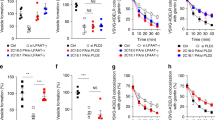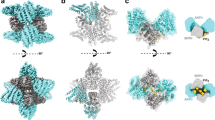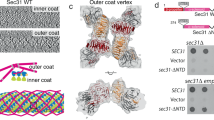Abstract
Protein coats deform flat lipid membranes into buds and capture membrane proteins to form transport vesicles1,2,3. The assembly/disassembly cycle of the COPI coat on Golgi membranes is coupled to the GTP/GDP cycle of the small G protein Arf1. At the heart of this coupling is the specific interaction of membrane-bound Arf1–GTP with coatomer, a complex of seven proteins that forms the building unit of the COPI coat4,5,6,7. Although COPI coat disassembly requires the catalysis of GTP hydrolysis in Arf1 by a specific GTPase-activating protein (ArfGAP1)8,9,10, the precise timing of this reaction during COPI vesicle formation is not known. Using time-resolved assays for COPI dynamics on liposomes of controlled size, we show that the rate of ArfGAP1-catalysed GTP hydrolysis in Arf1 and the rate of COPI disassembly increase over two orders of magnitude as the curvature of the lipid bilayer increases and approaches that of a typical transport vesicle. This leads to a model for COPI dynamics in which GTP hydrolysis in Arf1 is organized temporally and spatially according to the changes in lipid packing induced by the coat.
This is a preview of subscription content, access via your institution
Access options
Subscribe to this journal
Receive 51 print issues and online access
$199.00 per year
only $3.90 per issue
Buy this article
- Purchase on Springer Link
- Instant access to full article PDF
Prices may be subject to local taxes which are calculated during checkout




Similar content being viewed by others
References
Rothman, J. E. & Wieland, F. T. Protein sorting by transport vesicles. Science 272, 227–234 (1996)
Schekman, R. & Orci, L. Coat proteins and vesicle budding. Science 271, 1526–1533 (1996)
Kirchhausen, T. Three ways to make a vesicle. Nature Rev. Mol. Cell Biol. 1, 187–198 (2000)
Serafini, T. et al. ADP-ribosylation factor is a subunit of the coat of Golgi-derived COP-coated vesicles: a novel role for a GTP-binding protein. Cell 67, 239–253 (1991)
Donaldson, J. G., Cassel, D., Kahn, R. A. & Klausner, R. D. ADP-ribosylation factor, a small GTP-binding protein, is required for binding of the coatomer protein beta-COP to Golgi membranes. Proc. Natl Acad. Sci. USA 89, 6408–6412 (1992)
Orci, L., Palmer, D. J., Amherdt, M. & Rothman, J. E. Coated vesicle assembly in the Golgi requires only coatomer and ARF proteins from the cytosol. Nature 364, 732–734 (1993)
Zhao, L. et al. Direct and GTP-dependent interaction of ADP ribosylation factor 1 with coatomer subunit beta. Proc. Natl Acad. Sci. USA 94, 4418–4423 (1997)
Tanigawa, G. et al. Hydrolysis of bound GTP by ARF protein triggers uncoating of Golgi-derived COP-coated vesicles. J. Cell Biol. 123, 1365–1371 (1993)
Cukierman, E., Huber, I., Rotman, M. & Cassel, D. The ARF1 GTPase-activating protein: zinc finger motif and Golgi complex localization. Science 270, 1999–2002 (1995)
Reinhard, C., Schweikert, M., Wieland, F. T. & Nickel, W. Functional reconstitution of COPI coat assembly and disassembly using chemically defined components. Proc. Natl Acad. Sci. USA 100, 8253–8257 (2003)
Antonny, B., Huber, I., Paris, S., Chabre, M. & Cassel, D. Activation of ADP-ribosylation factor 1 GTPase-activating protein by phosphatidylcholine-derived diacylglycerols. J. Biol. Chem. 272, 30848–30851 (1997)
Stamnes, M., Schiavo, G., Stenbeck, G., Sollner, T. H. & Rothman, J. E. ADP-ribosylation factor and phosphatidic acid levels in Golgi membranes during budding of coatomer-coated vesicles. Proc. Natl Acad. Sci. USA 95, 13676–13680 (1998)
Yanagisawa, L. L. et al. Activity of specific lipid-regulated ADP ribosylation factor-GTPase-activating proteins is required for Sec14p-dependent Golgi secretory function in yeast. Mol. Biol. Cell 13, 2193–2206 (2002)
Mayer, L. D., Hope, M. J. & Cullis, P. R. Vesicles of variable sizes produced by a rapid extrusion procedure. Biochim. Biophys. Acta 858, 161–168 (1986)
Brown, M. T. et al. ASAP1, a phospholipid-dependent arf GTPase-activating protein that associates with and is phosphorylated by Src. Mol. Cell. Biol. 18, 7038–7051 (1998)
Randazzo, P. A. et al. The Arf GTPase-activating protein ASAP1 regulates the actin cytoskeleton. Proc. Natl Acad. Sci. USA 97, 4011–4016 (2000)
Spang, A., Matsuoka, K., Hamamoto, S., Schekman, R. & Orci, L. Coatomer, Arf1p, and nucleotide are required to bud coat protein complex I-coated vesicles from large synthetic liposomes. Proc. Natl Acad. Sci. USA 95, 11199–11204 (1998)
Bremser, M. et al. Coupling of coat assembly and vesicle budding to packaging of putative cargo receptors. Cell 96, 495–506 (1999)
Antonny, B., Madden, D., Hamamoto, S., Orci, L. & Schekman, R. Dynamics of the COPII coat with GTP and stable analogues. Nature Cell Biol. 3, 531–537 (2001)
Goldberg, J. Decoding of sorting signals by coatomer through a GTPase switch in the COPI coat complex. Cell 100, 671–679 (2000)
Chabre, M. Aluminofluoride and beryllofluoride complexes: new phosphate analogs in enzymology. Trends Biochem. Sci. 15, 6–10 (1990)
Scheffzek, K., Ahmadian, M. R. & Wittinghofer, A. GTPase-activating proteins: helping hands to complement an active site. Trends Biochem. Sci. 23, 257–262 (1998)
Finazzi, D., Cassel, D., Donaldson, J. G. & Klausner, R. D. Aluminum fluoride acts on the reversibility of ARF1-dependent coat protein binding to Golgi membranes. J. Biol. Chem. 269, 13325–13330 (1994)
Zhu, Y., Traub, L. M. & Kornfeld, S. ADP-ribosylation factor 1 transiently activates high-affinity adaptor protein complex AP-1 binding sites on Golgi membranes. Mol. Biol. Cell 9, 1323–1337 (1998)
Antonny, B., Gounon, P., Schekman, R. & Orci, L. Self-assembly of minimal COPII cages. EMBO Rep. 4, 419–424 (2003)
Presley, J. F. et al. Dissection of COPI and Arf1 dynamics in vivo and role in Golgi membrane transport. Nature 417, 187–193 (2002)
Yang, J. S. et al. ARFGAP1 promotes the formation of COPI vesicles, suggesting function as a component of the coat. J. Cell Biol. 159, 69–78 (2002)
Franco, M., Chardin, P., Chabre, M. & Paris, S. Myristoylation of ADP-ribosylation factor 1 facilitates nucleotide exchange at physiological Mg2+ levels. J. Biol. Chem. 270, 1337–1341 (1995)
Nickel, W. & Wieland, F. T. Receptor-dependent formation of COPI-coated vesicles from chemically defined donor liposomes. Methods Enzymol. 329, 388–404 (2001)
Matsuoka, K. & Schekman, R. The use of liposomes to study COPII- and COPI-coated vesicle formation and membrane protein sorting. Methods 20, 417–428 (2000)
Acknowledgements
We thank P. Randazzo and R. Premont for proteins and constructs, J. Moelleken for advice on coatomer purification and lipopeptide synthesis and M. Chabre for discussions. This work was supported by the CNRS (ACI ‘Jeune Chercheur’) and the EMBO Young Investigator Programme.
Author information
Authors and Affiliations
Corresponding author
Ethics declarations
Competing interests
The authors declare that they have no competing financial interests.
Supplementary information
Rights and permissions
About this article
Cite this article
Bigay, J., Gounon, P., Robineau, S. et al. Lipid packing sensed by ArfGAP1 couples COPI coat disassembly to membrane bilayer curvature. Nature 426, 563–566 (2003). https://doi.org/10.1038/nature02108
Received:
Accepted:
Issue Date:
DOI: https://doi.org/10.1038/nature02108
This article is cited by
-
The Functionality of Membrane-Inserting Proteins and Peptides: Curvature Sensing, Generation, and Pore Formation
The Journal of Membrane Biology (2023)
-
An N-terminal conserved region in human Atg3 couples membrane curvature sensitivity to conjugase activity during autophagy
Nature Communications (2021)
-
Structural characterization of coatomer in its cytosolic state
Protein & Cell (2016)
-
Membrane curvature bends the laws of physics and chemistry
Nature Chemical Biology (2015)
-
A sub-nanometre view of how membrane curvature and composition modulate lipid packing and protein recruitment
Nature Communications (2014)
Comments
By submitting a comment you agree to abide by our Terms and Community Guidelines. If you find something abusive or that does not comply with our terms or guidelines please flag it as inappropriate.



